
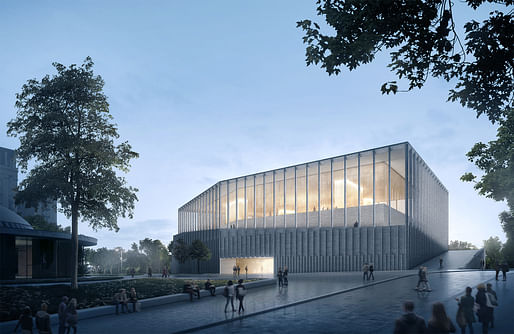
The winners of the Revolution of Dignity Museum competition was recently revealed! Following the Maidan Revolution Public Square competition in 2014 and organized by [phase eins], these competitions were launched to commemorate the historic Heavenly Hundred Heroes and the Revolution of Dignity events in Kiev, Ukraine.
Selected this past February, the three winners of the National Memorial of Heavenly Hundred Heroes competition were:
For the Revolution of Dignity Museum, out of the 12 proposals in stage one, six of them advanced to stage two. At the end of stage two, the international jury picked three prize-winning proposals, with first prize going to Berlin-based Kleihues + Kleihues Gesellschaft von Architekten. As the competition winner, the team's proposal will be realized.
Check out the top three Revolution of Dignity Museum proposals below.
1st prize (competition winner): Kleihues + Kleihues Gesellschaft von Architekten mbH
Architects: Prof. Jan Kleihues, Johannes Kressner/ Berlin, Germany
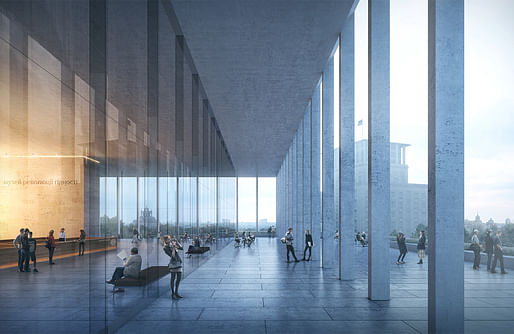


Excerpt of jury comments: This project is a simple, spiritual and characteristic piece of architecture, well integrated into its urban context, with a high degree of functionality. It is continuing the legacy of European Classical architecture in an interesting and modern way while responding to the complex and partially contradictory requirements of the site and the whole context. The solution offers a simple and graceful image that can be easily understood to be a museum that is also a memorial. The memories of the Heavenly Hundred Heroes and the respect for the sorrow of those who lost their loved ones create an impressive alliance in a proposal that contains a capacity to rekindle the architectural traditions of both Europe and the Ukraine.
The jury recommends this project to be executed as it believes that it provides a well worked-out design that meets all know requirements and is robust enough to respond to the inevitable changes that will be needed for the final optimization of the museum concept in dialogue between clients, architects and exhibition designers. Ultimately this proposal provides an elegant architectural image that integrates well into the historic context of the Maidan. The European traditions of Classical Architecture are being reinterpreted into a new language that will let this building stand out as one of the most characteristic museums of our time, leading the new institution of the “Museum of Freedom” into a future that will be highly relevant in the international cultural (and political) discourse.
2nd prize: BURØ/architects.
Architects: Anton Oliinyk, Oleksii Pakhomov / Kyiv, Ukraine

Excerpt of jury comments: The new scheme presents a strong composition consisting of seven stacks of monumental “stones” that are shifted in relation to each other in order to create dramatic interstitial spaces. These are volumes either literally clad in pavement stones or consist of glass façades with semi-transparent stone screens set in steel. This choice of material takes its lead from the first spontaneous monuments built just after the Maidan Revolution. [...]
The jury appreciates the symbolic monumental character of the sculptural concept of the stone-blocks with narrow gaps providing natural light into the circulation zones but is critical about the internal connections between the different parts of the program. Particularly the location of the lifts and stairs is not legible for the visitors. The choice of structural system seems to double up (columns and walls) and would need optimization. The proposal seems to be energy-efficient using the thermal mass of slabs and walls to heat and cool the building. Overall, the jury appreciates the creative autonomy of the projects and has its doubts an “architecture parlante” where symbol becomes architecture.
3rd prize: Lina Ghotmeh Architecture.
Architect: Lina Ghotmeh / Paris, France
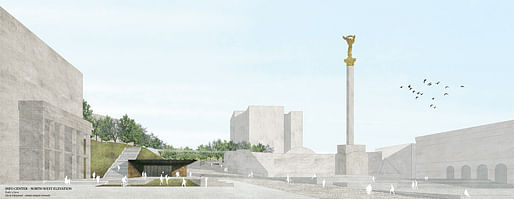
Excerpt of jury comments: The jury appreciates the idea of a museum that looks and works like a mountain. The design invites the visitor onto a spiraling rooftop path to the very top of the building thus offering a natural continuation to the Alley of the Heavenly Hundred Heroes in a simple and positive way. The roof terraces allow the visitors to literally take possession of the building and allow for interaction between visitors and neighbours before and after the museum visit. They also provide space for outdoor installations in addition to or as part of the museum exhibitions. Even though the scale and the routing developed from the Avenue of Heavenly Hundred seems appropriate, the jury doesn’t believe the integration of the building into its context is not completely convincing. [...]
The jury appreciates the serious work that was undertaken between stages1 and 2 to optimize the idea of a participatory museum building. However, ultimately, it also feels that this concept has led to a project which lacks iconic character and won’t be able to present a strong image when seen from afar. Overall, the jury judges this proposal as a bold and consistent concept of outstanding quality but is ultimately not convinced about its presence in the city.
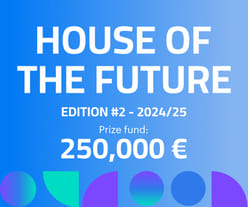
250,000 € Prize / HOUSE OF THE FUTURE 2024/25
Register by Wed, Apr 30, 2025
Submit by Mon, Jun 2, 2025

Ceramics of Italy Tile Competition
Register/Submit by Fri, Feb 14, 2025

Land Art Generator Initiative 2025 Fiji: Climate Resilience for Island Communities
Register/Submit by Mon, May 5, 2025
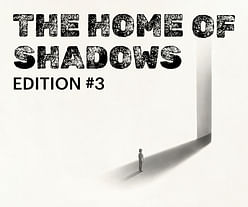
The Home of Shadows / Edition #3
Register by Wed, Jan 29, 2025
Submit by Mon, Mar 3, 2025
No Comments